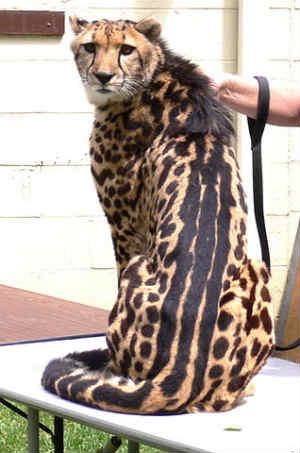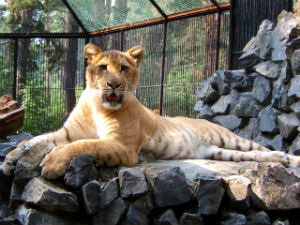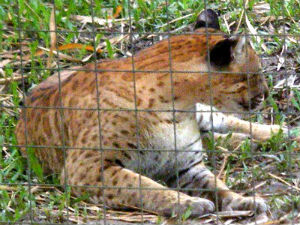Cat Hybrids
Family Felidae
Mammalian Hybrids
Note: Cat hybrids are extremely numerous. Whether because there is a keen interest among breeders in obtaining new types of cat hybrids or because cats have a innate tendency to hybridize, there are many different types of crosses known for Family Felidae.
Cat Hybrids - Reported crosses:
Acinonyx jubatus [Cheetah]
× Panthera pardus [Leopard] NHR?? In 1926 a cat, thought at the time to be a cheetah-leopard hybrid, was trapped near Harare, Zimbabwe. In build, it was cheetah-like, though a bit large, but its coat was leopard-like. Pocock (1927) described it as a new species, the King Cheetah (Acinonyx rex). However, only five more of these cats were sighted up to 1974, when one was photographed in South Africa’s Kruger National Park (tinyurl.com/y9ww3ks3). Two have been captured since. The rarity of these animals and their appearance raise the possibility that they are cheetah-leopard hybrids. However, Lindburg (1989) says king cheetahs are not hybrids, but instead cheetahs that are homozygous for a recessive tabby gene common to most cats, and that captive births at the De Wildt Research Centre (Pretoria, South Africa) show the king cheetah is merely a rare variant cheetah. Lindburg 1989; Pocock 1927. Pictures >>.
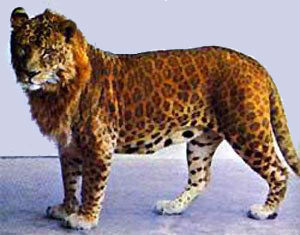 Leopon (Lion × Leopard)
Leopon (Lion × Leopard)More videos of ostensible cat-rabbit hybrids >>
Felis bengalensis [Leopard Cat]
× Felis catus (♀) [Domestic Cat] CANHR(Asia). HPF(♀♀). F₁ males are sterile or, at least, of very low fertility. Backcross hybrids to domestic are partially fertile in both sexes. This cross has been used to assist in mapping the cat genome. Backcross hybrids to domestic cat produced during the course of such research were obtained by Jean S. Mill of Millwood Bengals cattery in Covina, California. She used them to produce the well-known Bengal Cat breed (see picture at right). After further backcrossing to domestic, she obtained partially fertile males. Subsequent breeding among the hybrid descendants and selection produced a cat with both the exotic coat of a leopard cat and the amiable disposition of a domestic. Bengals are about 1/8 Leopard Cat. An internet site (XTFI) says that the Bengal’s “immediate ancestors are the domestic Ocicat and American Shorthair and the wild Leopard Cat (Felis bengalensis). The breeding program, executed by Jean Mill of Millwood Cattery in Covina, California, involved several generations of crossbreeding until the proper coloration and temperament was achieved. With the basic body structure of the Ocicat, the loving disposition of the American Shorthair, and the beautiful coat of the Leopard Cat, the Bengal is indeed a striking and unique cat.” Three-way hybrids have been produced by crossing F. bengalensis × F. catus hybrids with F. chaus, F. geoffroyi, F. rufus, and F. viverrina. Austin et al. 1948 (pp. 37-38); International Zoo Yearbook 1965 (p. 339), 1975 (p. 376); Johnson 1991; Lyons and O’Brien 1994; Menotti-Raymond et al. 1999; 2003; McMaster 1871 (p. 221); Murphy et al. 2000; Nowell and Jackson 1996; O’Brien et al. 2002 (Fig. 1)†; Robinson 1979; Yosida 1982a, 1982b†. Internet Citations: MESS2, LAIR †, PETD, SPOTS.
× Felis chaus [Jungle Cat] CHR. CON: Pakistan, India, southeastern Asia. International Zoo Yearbook 1970 (p. 264).
× Felis rufa [Bobcat] An Internet site on cat breeding (CENT) says the Highland Lynx breed is a “Bobcat × F. bengalensis (or Bengal) × domestic hybrid.” However, another (IFNE) lists it as “Desert Lynx (Bobcat × Abyssinian) × Jungle Curls (F. chaus hybrid).”
× Felis serval [Serval] CHR. A hybrid was produced at Gentleshaw Wildlife Centre in the UK. Picture: tinyurl.com/jkcrsc5.
Felis braccata [Pantanal Cat]
× Felis tigrina (↔) [Oncilla] CAONHR. CON: southern Brazil, Paraguay. In Brazil, Johnson et al. (1999) identified natural hybrids from Santa Catarina (Camboriu), Goias, and the Distrito Federal. They list the cross as “Lynchailurus colocolo × Leopardus tigrinus”, but given the provenance of the hybrids, braccata, which is sometimes lumped with colocolo, is implicated. Hybrids of both sexes have been reported. A captive hybrid was larger than either parent and was spotted like an oncilla, but the spots were less distinct. Hemmer 1979†.
|
|
|
Canadian Lynx (Felis canadensis) |
Felis canadensis [Canadian Lynx]
× Felis pardina [Spanish Lynx] CHR. DRS. These cats are sometimes lumped. Internet Citations: MESS3.
× Felis rufa (♂) [Bobcat] CAONHR(northern U.S.). HPF(♀♀). In a small survey (20 specimens) from northeastern Minnesota three (15%) were hybrid. They had large feet and a mostly black tail band (like lynx), but short ear tufts and compact bodies (like bobcats). Internet reports say a female hybrid was found in Michigan with kittens, and that two additional hybrids were previously identified in Maine (Moosehead region). There is a parapatric contact zone in Washington, Montana, Wyoming, Idaho, Colorado, and southern Ontario. Conservation interest in this cross is keen—the Canadian lynx is listed as threatened in its entire U.S. range. F. canadensis occurs at higher latitudes and altitudes than F. rufa. Captive hybrids between F. rufa and any lynx (F. canadensis, F. lynx, or F. pardina) are called “blynxes.” Homyack, et al. 2008; Schwartz et al. 2004. Internet Citations: BLYNX; FELI; MESS3; LAIR†.
Felis caracal [Caracal]
× Felis catus [Domestic Cat] CHR(Moscow). CON: Africa, Middle East. Kusminych and Pawlowa 1998.
× Felis serval (↔) [Serval] CHR. HPF. CON: Africa. These hybrids are called “servicals” (F. serval ♂ × F. caracal ♀) or “caravals” (F. serval ♀ × F. caracal ♂). Of these two cat hybrids, the caraval is far more common and is bred for the pet market. The Los Angeles Zoo reported four hybrids (three males and one female) in 1989. International Zoo Yearbook 1990 (p. 464); MESS3†, LAIR†.
|
Rabbit-cat hybrids - Fact or fiction?
|
Note: There have been many different types of domestic cat hybrids reported over the years, some of them so strange as to seem quite dubious. Such crosses require further verification.
Felis catus [Domestic Cat]
See also: Felis bengalensis; F. caracal.
× Anas platyrhynchos [Domestic Duck] See the separate article “Duck-cat hybrids.”
× Canis familiaris [Domestic Dog] See the separate article “Dog-cat hybrids.”
× Didelphis virginiana [Virginia Opossum] See the separate article “Opossum-cat hybrids.”
× Equus caballus [Domestic Horse] See the separate article “A Horse-cat Hybrid?.”
× Felis chaus (♂) [Jungle Cat] CAENHR(India). HPF(♀♀). These cat hybrids are large and vigorous. The Chausie breed of domestic cat (see picture above right) is derived from this cross. Chausies have also been crossed with F. silvestris to produce a breed known as the “Euro-Chausie.” With respect to F. chaus, Darwin (1883, vol. 1, p. 31) states that “Sir W. Elliot, informs me that he once killed, near Madras, a wild brood, which were evidently hybrids from the domestic cat; these young animals had a thick lynx-like tail and the broad brown bar on the inside of the forearm characteristic of F. chaus. Sir W. Elliot adds that he has often observed this same mark on the forearms of domestic cats in India. Mr. Blyth states that domestic cats coloured nearly like F. chaus, but not resembling that species in shape, abound in Bengal; he adds, ‘such a colouration is utterly unknown in European cats, and the proper tabby markings (pale streaks on a black ground, peculiarly and symmetrically disposed), so common in English cats, are never seen in those of India.’” Blyth 1863b (p. 184); Darwin 1868 (vol. 1, p. 45); Flower 1929a (p. 81); Jerdon 1874 (p. 112); Robinson 1979; Zuckerman 1953 (p. 839). Internet Citations: LAIR†, MESS2†.
× Felis geoffroyi [Geoffroy’s Cat] CANHR. HPF (F. catus male × F. geoffroyi female). CON: southern South America. This cat hybrid is known as the “Safari.” Warren and Riedel 1980. Internet Citations: MESS2, PETD.
× Felis lynx [Eurasian Lynx] CHR. CON: Eurasia. Ackermann 1898 (p. 54).
× Felis manul [Pallas’s Cat] See the separate article “Domestic Cat-Pallas's Cat hybrids.”
× Felis margarita (♂) [Sand Cat] CHR. A commercial breeders' site (tinyurl.com/jlxdqtp) lists this hybrid as having been definitely produced and states that “Kittens were born to a domestic female, sired by a male Sand Cat, in 2013.” Sand cats probably come into contact with feral domestic cats in the vicinity of human habitations in the arid regions of North Africa.
× Felis nigripes (♂) [Black-footed Cat] CHR. HPF. CON: southern Africa. Hybrids of both sexes have been reported. Leyhausen and Tonkin 1966; Robinson 1979. Internet Citations: MESS2, WIKI.
× Felis pardalis (♀) [Ocelot] CHR. A commercial breeders' site (tinyurl.com/jlxdqtp) lists this hybrid as having been definitely produced and states that “Two litters of confirmed hybrids between a female ocelot and male Bengal were born in 2007 and 2008.” A Bengal is a hybrid of a domestic cat and an Asian leopard cat (Felis bengalensis).
× Felis rubiginosa [Rusty-spotted Cat] CANHR. HPF. CON: India, Sri Lanka. These cats hybridize freely in captivity and natural hybrids apparently also occur. F. rubiginosa, also known as Prionailurus rubiginosus, is rated as vulnerable by the IUCN. Blyth 1863b (p. 184), Jerdon 1874; Kittle and Watson 2004. Internet Citations: LAIR.
× Felis rufa (♂) [Bobcat] Cat hybrids of this type are known as “American Lynx,” “Desert Lynx,” and “Legend Cat.” The “Bonx” is a Manx × Bobcat hybrid. The “Pixie-bob” breed is said to be derived from this cross. As a child, the author had an F₁ hybrid cat of this type. A breeder’s website (TAKO) says that “while the Desert Lynx today is a completely domestic cat, it had its origins in bobcat/domestic crosses. Through generations of selective breeding with different breeds of domestic cats, the breed has incorporated many characteristics similar to those of the bobcat.” Gashwiler et al. 1961; Robinson 1979; Young 1958. Internet Citations: PETD, TAKO†.
× Felis serval [Serval] CHR. CON: Africa, southwestern Asia. This cat hybrid is called the “Savanna.” The largest commercially available hybrid cat. Has black stripes and spots on a silver to gold or brown background. Eye marks are like a cheetah’s. Internet Citations: PETD.
× Felis silvestris [Wildcat] See the separate article “Wildcat-cat hybrids.”
× Felis tigrina (♂) [Oncilla] CHR. CON: Central and South America. LFH. Parents differ markedly in karyotype. Of seven hybrids, three were still-born (unsexed). The remaining four were female. Coat pattern resembles that of Geoffroy’s Cat (Felis geoffroyi). Hybrids from the reciprocal cross died at or soon after birth. Leyhausen and Falkena 1966; Robinson 1979. Internet Citations: MESS2.
× Felis viverrina [Fishing Cat] CHR. CON: southeast Asia, Indonesia. LFH. This cat hybrid is known as the “Machbagral” or “Bagral.” Blyth 1863b (p. 184). Internet Citations: PETD.
× Felis wiedii [Margay] CHR. HPF. CON: Central America, northern South America. Experimental hybrid was known as the “Bristol.” Méry 1968. Internet Citations: MESS2; PETD.
× Felis yaguarundi [Eyra Cat | Jaguarundi] CANHR?? CON: Central and South America. Available evidence appears to be insufficient to establish the occurrence of this cross. There are, however, extremely old reports of natural hybridization. Thus, Morton (1847b, p. 275) says, “De Azara [1802] states that in the forest of Paraguay the Felis yaguarundi and the Felis eyra, both unite with the domestic cat; and he holds, that should these wild species become in time extirpated, and the mixed breed alone remain, the latter would be very naturally referred with all its varieties, to a single original species.” Felis eyra is a synonym of Felis yaguarundi. This cross has also been reported on the Internet as having occurred in captivity, but this needs confirmation. Internet Citations: MESS2; PETD.
× Gallus gallus [Domestic Fowl] See the separate article “Cat-chicken Hybrids.”
× Macropus sp. See the separate article “Cat-kangaroo Hybrids?”.
× Martes foina [Beech Marten] See the separate article “Marten-cat hybrids.”
× Martes martes [Pine Marten] See the separate article “Marten-cat hybrids.”
× Mephitis mephitis [Striped Skunk] See the separate article “Skunk-cat Hybrids.”
× Mustela putorius [European Polecat] A cat-polecat hybrid mentioned in Pallas (1812, pp. 48-49), which is an English translation of Bemerkungen auf einer Reise in die südlichen Statthalterschaften des Russischen Reichs in den Jahren 1793 und 1794 (Pallas 1803), mistranslates the German word Marder as “polecat,” but the correct meaning is “marten.” See the separate article “Marten-cat hybrids.”
× Ondatra zibethicus (♂) [Muskrat] George Lyman Kittredge (1916, p. 37) writes that in 1716 the New England Puritan minister and author Cotton Mather (1663-1728) reported to the Royal Society of London that a cat in Roxbury, Massachusetts had bred with a muskrat and brought forth a numerous litter of kittens, all of which were of a mixed form, some more resembling muskrat, others, cat. In the same article (p. 18), Kittredge states that “No historical student would think of denying that Cotton Mather was one of the best informed Americans of his time in scientific matters.” Kittredge (1860-1941) was a celebrated professor and scholar of English literature at Harvard University.
× Oryctolagus cuniculus [European Rabbit] See the separate article “Rabbit-cat hybrids.”
× Primates sp. [“Monkey”] A litter of cat-monkey hybrids is mentioned on page 19, column 3, of the February 14, 1920, issue of Smith's Weekly, a newspaper published in Sydney, New South Wales, Australia (source). The anonymous author of the brief report states that a previous report in Smith's Weekly, about a different type of hybrid, had brought to mind “a litter of monkey-cats, born at Paddington (Sydney) thirty years ago. The parents, monkey and cat, were owned by Bob Jones, son of the well-known contractor. The monkey was a great favourite with the cats of the immediate neighbourhood, who visited him so frequently, and made so much noise at the meetings, that Jones was forced to get rid of the monk. The hybrid family numbered four, I think, but were all promptly drowned by the owner of the monkey.” So this supposed event would have dated to around 1890. Although the monkey in the preceding account was not identified as to type, a likely candidate would be a capuchin monkey. The familiar organ grinder’s monkeys were capuchins, which were widely kept as pets during the nineteenth and early twentieth centuries. It is not unusual for shocked owners to put strange hybrids, which they perceive as monstrous, to death soon after birth. See also the separate article “A Cat-human Hybrid?”
× Ovis aries [Domestic Sheep] In a very early record Kundmann (1737, p. 821) says he had in his collection of curiosities "a sheep with a head like that of a cat."
× Procyon lotor [Northern Raccoon] See the separate article “Raccoon-cat hybrids.”
× Rattus rattus [Black Rat] See the separate article: “Rat-cat hybrids.”
× Sciurus vulgaris [Eurasian Red Squirrel] See the separate article: "Squirrel-cat hybrids.
+ Sorex araneus [Common Shrew] An old German periodical, Allgemeine Forst- und Jagdzeitung (1839, vol. 8, p. 234; tinyurl.com/pqlj3uq), states that it had formerly been widely believed that this bizarre cross sometimes occurred. Not surprisingly, it appears there is no evidence whatsoever that it ever did.
× Trichosurus vulpecula [Common Brush-tail Possum] See the separate article “Possum-cat hybrids.”
× Vulpes vulpes [Red Fox] NHR?? An old news report describes a hybrid of this type. It appeared on page 2, col. 4 of the Jan. 2, 1911 issue of the Norwich bulletin published in Norwich, Connecticut (source). It reads as follows: “George Pierce of North Sterling is making a record that will put him in line for proclamation as the champion fox hunter of Windham county He killed five of the animals during December, one of them hybrid, half fox, half wildcat weighing nine and one-half pounds. This animal is described as having a head of the shape of a fox with cat's ears and teeth. The animal was undoubtedly much the same as the one shot at South Killingly last winter and later exhibited in Danielson.” Note that from the description it is unclear whether the suggested feline parent is a bobcat (Felis rufa) or simply a wild cat (Felis cattus).
Felis chaus [Jungle Cat]
See also: Felis bengalensis × F. catus; F. catus.
× Felis rufa [Bobcat] CHR. DRS. Known as “Jungle Lynx.” Internet Citations: MESS2.
× Felis silvestris [Wildcat] CHR. CON: India and the Middle East. A new breed of cat, the Euro-Chaus, has recently been produced from crossing (European) wildcats with jungle cats. Internet Citations: MESS2.
Note: Two populations, coryi and stanleyana, treated as races of Felis concolor, formerly hybridized in eastern Texas, Oklahoma, and Missouri (central U.S.). Coryi hybridized, too, with a third population so treated (cougar) in Tennessee, and in N. and S. Carolina. However, populations of mountain lions in these regions are now so sparse that hybridization may no longer occur at significant levels. Lowery 1974 (p. 466).
Felis concolor [Puma]
× Bos taurus [European Domestic Cattle] See the separate article “A Cow-puma Hybrid?”
× Canis familiaris [Domestic Dog] See the separate article “Dog-puma Hybrids?”
× Felis pardalis (↔) [Ocelot] CHR. CON: Central and South America. In one case described by Dubost and Royère, the parents were raised together and had been caged in the same enclosure for years. The puma dam was about three times the sire’s size. At least four litters were born, but not properly cared for by the mother (in fact, she ate one litter). The keepers lacked appropriate formula for hand feeding. All died within a few days, but probably could have been raised with the proper feed. The cubs had ocelot-like spotting, which was somewhat variable, less continuous dorsally, and fainter ventrally. Legs were dark and unspotted caudally; tails, ringed. Another hybrid mentioned on Wikipedia and pictured above was in the possession of the Zoo de Guyane, Macouria, French Guyana in 2012. Its mother was a female ocelot. Dubost and Royère 1993†. Internet Citations: MESS3†.
× Panthera onca [Jaguar] CON: Central and South America. Gray (1958, p. 37) says, “Successful hybridization has been alleged.” She cites only Hemmer (1966) who does not list this cross. In Latin America there are reports that jaguars and pumas do cross in the wild. And in an old report Félix de Azara (de Azara 1801, p. 137; see also de Azara 1802 p. 122) writes, “They say that if a puma comes upon a female jaguar in heat, he covers her and puts the males, after overcoming them, to flight. If this is true, it’s because they are more nimble and give the jaguars no opportunity to defeat them, for without doubt they are both much weaker and less bold than jaguars. It is also said that a few hybrid individuals have been seen and that they are stronger and more bloodthirsty than either of the parents, and that the hair or color of the hybrids is more like that of the cougar, who is their father, though they do have plenty of the mother’s spots.” [Translated by E. M. McCarthy. Original French.]
× Panthera pardus (↔) [Leopard] CHR. DRS. This cat hybrid is known as a “Pumapard.” Hybrids are puma-colored, but have pale brown spots. They have long tails, but are much smaller than leopards or pumas. Hemmer says, the feet, stomach, and flanks of one hybrid were leopard-like, the back, tail, and muzzle, puma-like. Carl Hagenbeck (1844-1913), the German animal dealer and showman, successfully fostered one (F. concolor male × P. pardus female) on a Fox Terrier. Its body length was much shorter than that of either parent. This animal was stuffed and is now on display in the Tring Museum. Haltenorth reports the reciprocal cross. Antonius 1951b; Gray 1972; Hagenbeck 1909 (p. 116); Haltenorth 1936†; Hemming 1966 (p. 102); Krumbiegel 1953-1955; Petzsch 1956; Rörig 1903. Internet Citations: GREE1†, LAIR †, MESS3†, WCPP †.
× Ursus americanus [Black Bear] See the separate article "A Puma-bear Hybrid?".
Felis geoffroyi [Geoffroy’s Cat] See: Felis bengalensis; F. catus.
× Felis tigrina [Oncilla] ENHR(southern Brazil). There is a hybrid zone in Rio Grande do Sul. Mazim et al. 2004; Trigo et al. 2008.
Felis lynx [Eurasian Lynx]
See also: F. catus.
× Felis rufa [Bobcat] CHR. DRS. Internet Citations: FELI.
× Felis serval [Serval] CHR. According to an article in the Orlando Sentinel in 2004, Jana Londre of Boca Raton, Florida had owned a hybrid of this type since 1992.
Felis margarita (♂) [Sand Cat] See: Felis catus .
Felis manul [Pallas’s Cat] See: Felis catus.
Felis nigripes [Black-footed Cat]
See also: Felis catus.
× Felis silvestris [Wildcat] CHR. HPF. CON: southern Africa. Contact is with F. silvestris caffra, formerly treated as a separate species (F. caffra, Caffer Cat). Internet Citations: MESS2.
Felis pardalis [Ocelot]
See also: Felis catus; F. concolor.
× Felis wiedii (♂) [Margay] CHR. CON: Central and South America. This cat hybrid is called a “marlot.” Internet Citations: FCF.
× Felis rufa (♀) [Bobcat] CHR. CON: northern Mexico, southwestern U.S. These hybrids are called ocebobs or bobelots. Internet Citations: BOBLY.
Felis pardina [Spanish Lynx]
See also: Felis canadensis.
× Felis rufa [Bobcat] CHR. Captive hybrids between F. rufa and any lynx (F. canadensis, F. lynx, or F. pardina) are called “blynxes.” Internet Citations: FELI.
Felis rubiginosa [Rusty-spotted Cat] See: Felis catus.
Note: Captive hybrids between F. rufa and any lynx (F. canadensis, F. lynx, or F. pardina) are called “blynxes.”
Felis rufa [Bobcat] See: Felis bengalensis; F. canadensis; F. catus; F. chaus; F. lynx; F. pardalis; F. pardina; Felis cattus × Vulpes vulpes.
Felis serval [Serval]
See also: Felis bengalensis; F. caracal; F. catus; F. lynx.
× Felis silvestris (♀) [Wildcat] CHR. HPF. CON: Africa. Burger 1978; International Zoo Yearbook 1978 (p. 389), 1981 (p. 322).
Note: As treated here, Felis silvestris includes cafra, lybicus, ocreata, ornata,and torquata.
Felis silvestris [Wildcat] See: Felis catus; F. catus × F. chaus; F. chaus; F. serval.
Felis tigrina [Oncilla] See: Felis braccata; F. catus; F. geoffroyi.
Felis torquata [Spotted Wildcat] This cat is treated as a separate species by Indian taxonomists, but is here lumped with F. sylvestris.
Felis viverrina [Fishing Cat] See: Felis bengalensis × F. catus; F. catus.
Felis wiedii [Margay] See: Felis catus; F. pardalis.
Felis yaguarundi [Eyra Cat | Jaguarundi] See: Felis catus.
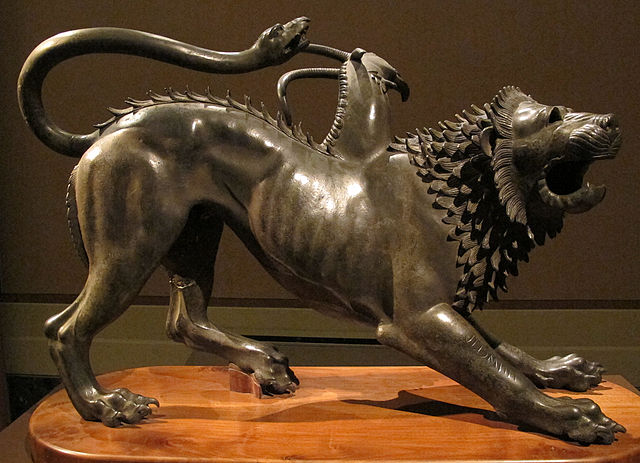 Chimera of Arezzo. Etruscan bronze statue, c. 400 B.C. Unearthed by construction workers at Arezzo in Italy in 1553, it combines features of a lion, goat and snake. National Archaeological Museum. Image: I, Sailko, Wikimedia, CC BY-SA 3.0.
Chimera of Arezzo. Etruscan bronze statue, c. 400 B.C. Unearthed by construction workers at Arezzo in Italy in 1553, it combines features of a lion, goat and snake. National Archaeological Museum. Image: I, Sailko, Wikimedia, CC BY-SA 3.0.
|
How could it be that she, Chimera lone,
With triple body—fore, a lion she; And aft, a dragon; and betwixt, a goat— Might at the mouth from out the body belch Infuriate flame? .
—Lucretius, Book V
|
Panthera leo [Lion]
× Bos taurus [European Domestic Cattle] The Viennese newspaper Die Presse alleged (Apr. 11, 1868, p. 14) that a cow had recently given birth to a calf "whose front half was deceptively like that of a lion."
× Canis familiaris [Domestic Dog] Not surprisingly, there appear to be no reliable reports of dog-lion hybrids, but Aristotle (On the Generation of Animals 747b33-36) states the following: "a dog differs in species from a lion, and the offspring of a male dog and a female lion is different in species." Video of a dog attempting to mate with a lion >>
× Hyaena hyaena [Striped Hyena] Ancient authors mention this cross, but such claims have not been substantiated by any reliable modern report. Pliny the Elder (Naturalis Historia, VIII, xlv) relates an ancient myth, saying that when a lioness is crossed with a hyena, it “gives birth to the corocotta, that mimics the voices of men and cattle. It has an unbroken ridge of bone in each jaw, forming a continuous tooth without any gum, which, to prevent its being blunted by contact with the opposite jaw, is shut up in a sort of case” (Rackham 1961).
× Panthera onca (♂) [Jaguar] CHR. DRS. These hybrids are called jaglions. A pair of well-documented hybrids, one of each sex, were born at Bear Creek Sanctuary near Barrie, Ontario in Canada in 2008 (Intenet Citations: BEARC). Both reached maturity. The female was darkly melanistic. The Bear Creek website describes these hybrids as “beautiful, perfect, healthy and active.” Both were still alive as of July, 2012. Older reports of this cross all seem to refer to reports of a different, three-way hybrid: P. leo ♂ × (P. onca × P. pardus) ♀. A hybrid is on display at the Rothschild Zoological Museum in Tring, England, displayed as a jaglion (GREE1), is probably this three-way cross. See the separate articles “Jaguar-leopard Hybrids” and “Jaguar-lion Hybrids”). Flower 1929a; Hemmer 1968b†, 1968c. Internet Citations: GREE1†.
× Panthera pardus (↔ usu. ♂) [Leopard] CHR. See the separate article “Leopon.”
× Panthera tigris (↔ usu. ♀) [Tiger] CHR. NHR?? HPF(♀♀). See the separate article “Liger (Lion × Tigress).”
Panthera onca [Jaguar]
See also: Felis concolor; Panthera leo.
× Panthera pardus (↔) [Leopard] See the separate article “Jaguar-leopard Hybrids.”
× Panthera tigris [Tiger] The existence of a hybrid of this type, “Mickey the tiguar,” at Mexico’s Altiplano Zoo was much discussed on the Internet. However, the rumors were dispelled by the following eye-witness report (Internet Citations: TIJAG): “I gave a conference at the Universidad Autonoma de Tlaxacala yesterday. When I asked about the tiguar, other professors told me that they had never heard of it. I asked a former student of mine to take me to the Zoologico del Altiplano. I went this morning. I found a pleasant middle-sized zoo. It had a nice feline section with African lions, puma, 2 Siberian tigers which I saw mating, 2 jaguars (black and spotted) and bobcats. No tiguar. When I asked a girl from the staff, she told me that there was no such animal. “Why would we do that difficult mating”, she answered very surprised. I will place some photos of the Zoologico del Altiplano later, it is not such a bad place. As I tell my students, do not believe everything you read on internet, go for the direct empirical facts. So again, Mickey the tiguar does not exist.” Therefore, since there are apparently no reports of any other tiguars, hybrids of this type are at present unknown.
Panthera pardus [Leopard]
See also: Felis concolor; Panthera leo; P. onca.
×Camelus dromedarius [Dromedary] In ancient times, as well as later, in the medieval era, it was believed that giraffes were the product of this cross. Thus, the Greco-Roman poet Oppian (Cynegetica, III), referring to giraffes (also known as camelopards), wrote "Tell also, I pray thee, O clear-voiced Muse of diverse tones, of those tribes of wild beasts which are of hybrid nature and mingled of two stocks, even the Pard of spotted back joined and united with the Camel." However, no such hybrid is known.
× Canis lupus [Wolf] This cross, mentioned in early natural histories, supposedly produced the “lycopanther.” This claim has not, however, been substantiated by any reliable modern report. Gesner (1560, p. 68), Zirkle 1935 (p. 33).
× Panthera tigris [Tiger] See the separate article “Leopard-tiger hybrids.”
Panthera spelea [Cave Lion] See the separate article “Liger (Lion × Tigress).”
Panthera tigris [Tiger]
See also: Panthera leo; P. onca; P. pardus.
× Canis familiaris [Domestic Dog] Although there appear to be no reliable reports of hybrids of this type, Aristotle (History of Animals, Book VIII, Chapter 27) does offer the following bit of hearsay in connection with this cross: “They say that the Indian dogs are derived from the tiger and the dog not directly, but from the third mixture of the breeds, for they say that the first race was very fierce. They take the dogs and tie them up in the desert. Many of them are devoured if the wild animal does not happen to desire sexual intercourse.” For further discussion of this topic in Aristotle, see Platt (1909). Likewise, Diodorus Siculus (Library of History, XVII.92) states that an Indian ruler, Sopeithes, gave Alexander the Great a gift of tiger-dog hybrids: “To Alexander he presented many impressive gifts, among them one hundred and fifty dogs remarkable for their size and courage and other good qualities. People said that they had a strain of tiger blood. He wanted Alexander to test their mettle in action, and he brought into a ring a full grown lion and two of the poorest of the dogs. He set these on the lion, and when they were having a hard time of it he released two others to assist them. The four were getting the upper hand over the lion when Sopeithes sent in a man with a scimitar who hacked at the right leg of one of the dogs. At this Alexander shouted out indignantly and the guards rushed up and seized the arm of the Indian, but Sopeithes said that he would give him three other dogs for that one, and the handler, taking a firm grip on the leg, severed it slowly. The dog, in the meanwhile, uttered neither yelp nor whimper, but continued with his teeth clamped shut until, fainting with loss of blood, he died on top of the lion.” A video on YouTube shows a tame tiger mating with a large dog (a Rottweiler) in captivity.
By the same author: Handbook of Avian Hybrids of the World, Oxford University Press (2006).
